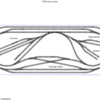I am just entering the world of command control. Thirty+ years ago, when my children were young, I bought them each a nice Fundimensions Southern Pacific engine. We set up a 12' x 9' layout in our finished basement with three loops and ran a GS4, an FM, a F3 and a GP7, all conventional of course. We dismantled the layout around 2002. My daughter has three sons and I bought then each two engines around 2005, all TMCC. We have 3 PRR K4s, 2 GG1s and 2 GP7s. We had intentions of a building a permanent layout, but there never seemed to be enough time. So, my only experience with TMCC has been two small loops around the Christmas tree. When our finished basement flooded this past July, we decided, after it was restored to build an 8' by 20' permanent layout.
My first action was to design a track plan with SCARM. After many revisions, we settled on the attached plan and I bought the track (all fastrack). In my spare time this past fall, I was busy with the basement restoration, so not much else happened. Then, over Christmas my son and I built the benchwork. I realized that I had to upgrade my power and have been researching as much as I could. I did purchase 2 180 watt Powerhouses at a good price along with 2 Legacy Powermasters. I am struggling a bit with the wiring and power plan. Here are my main questions:
1. I plan to run 16 gauge BUS wiring with 18 gauge feeders to spread power across the layout. Should I create several power blocks and run a BUS for each? I think I can isolate blocks at the switches so I can use the 1 3/8 inch extenders to cut power. I think I need blocks for the passings and for the sidings, correct? I'm not sure we'll run anything but TMCC, but it would be nice to run the older conventional engines as well if it doesn't complicate things too much. We may never expand into Legacy, but one never knows (my youngest son has two very young children).
2. One of the 180 bricks should run the outer loop and siding and one the inner. What about the connecting tracks and yard area?
3. The more modern power I bought should protect the engine electronics. Should I add TVS protection as well? How do I phase the bricks?
4. Lights and accessories will be run by my 1946 ZW. I also have a C-80, should I use it somehow.
5. How do I turn power off and on to each block? My plan is to use toggle switches. Is there a better way?
6. All of the switches are the newest R/C. Should I wire them anyway?
7. I didn't buy any fastrack lockon pieces. I think I can run the feeders under the benchwork to connect power, correct?
8. The plywood table is covered by 1 inch high density foam and then by 3/4 inch white beaded foam for sound deadening. I plan to screw the fastrack only into the foam. Do I have to screw down each piece? Is there a better alternative?
Basically I'm asking for advice on laying and powering the track for reliable operation. Thanks in advance for any advice.





